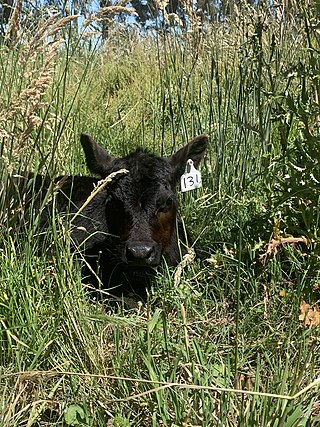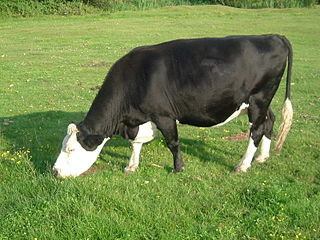Related Research Articles

A calf is a young domestic cow or bull. Calves are reared to become adult cattle or are slaughtered for their meat, called veal, and their hide.

Ehlers–Danlos syndromes (EDS) are a group of 13 genetic connective-tissue disorders in the current classification, with the latest type discovered in 2018. Symptoms often include loose joints, joint pain, stretchy velvety skin, and abnormal scar formation. These may be noticed at birth or in early childhood. Complications may include aortic dissection, joint dislocations, scoliosis, chronic pain, or early osteoarthritis.

The Aberdeen Angus, sometimes simply Angus, is a Scottish breed of small beef cattle. It derives from cattle native to the counties of Aberdeen, Banff, Kincardine and Angus in north-eastern Scotland. In 2018 the breed accounted for over 17% of the beef production in the United Kingdom.

Arthrogryposis (AMC) describes congenital joint contracture in two or more areas of the body. It derives its name from Greek, literally meaning 'curving of joints'.

Antoine Bernard-Jean Marfan was a French paediatrician.
A connective tissue disease (collagenosis) is any disease that has the connective tissues of the body as a target of pathology. Connective tissue is any type of biological tissue with an extensive extracellular matrix that supports, binds together, and protects organs. These tissues form a framework, or matrix, for the body, and are composed of two major structural protein molecules: collagen and elastin. There are many different types of collagen protein in each of the body's tissues. Elastin has the capability of stretching and returning to its original length—like a spring or rubber band. Elastin is the major component of ligaments and skin. In patients with connective tissue disease, it is common for collagen and elastin to become injured by inflammation (ICT). Many connective tissue diseases feature abnormal immune system activity with inflammation in tissues as a result of an immune system that is directed against one's own body tissues (autoimmunity).
Hereditary inclusion body myopathies (HIBM) are a group of rare genetic disorders which have different symptoms. Generally, they are neuromuscular disorders characterized by muscle weakness developing in young adults. Hereditary inclusion body myopathies comprise both autosomal recessive and autosomal dominant muscle disorders that have a variable expression (phenotype) in individuals, but all share similar structural features in the muscles.

Neospora is a single celled parasite of livestock and companion animals. It was not discovered until 1984 in Norway, where it was found in dogs. Neosporosis, the disease that affects cattle and companion animals, has a worldwide distribution. Neosporosis causes abortions in cattle and paralysis in companion animals. It is highly transmissible and some herds can have up to a 90% prevalence. Up to 33% of pregnancies can result in aborted fetuses on one dairy farm. In many countries this organism is the main cause of abortion in cattle. Neosporosis is now considered as a major cause of abortion in cattle worldwide. Many reliable diagnostic tests are commercially available. Neospora caninum does not appear to be infectious to humans. In dogs, Neospora caninum can cause neurological signs, especially in congenitally infected puppies, where it can form cysts in the central nervous system.

Bethlem myopathy is predominantly an autosomal dominant myopathy, classified as a congenital form of limb-girdle muscular dystrophy. There are two types of Bethlem myopathy, based on which type of collagen is affected.
Congenital contractural arachnodactyly (CCA), also known as Beals-Hecht syndrome, is a rare autosomal dominant congenital connective tissue disorder. As with Marfan syndrome, people with CCA typically have an arm span that is greater than their height and very long fingers and toes. However, Beals and Hecht discovered in 1972 that, unlike Marfan's, CCA is caused by mutations to the fibrillin-2 (FBN2) gene rather than the fibrillin-1 (FBN1) gene.

The Black Hereford is a crossbreed of beef cattle produced in Britain and Ireland with Hereford beef bulls and Angus. Black Herefords are not usually maintained from generation to generation, but are constantly produced as a byproduct of a terminal cross. They are one of the most common types of beef cattle in Britain and Ireland, outnumbering many pure beef breeds.

Marden–Walker syndrome (MWS) is a rare autosomal recessive congenital disorder. It is characterized by blepharophimosis, microcephaly, micrognathia, multiple joint contractures, arachnodactyly, camptodactyly, kyphoscoliosis and delayed motor development and is often associated with cystic dysplastic kidneys, dextrocardia, Dandy–Walker malformation and agenesis of corpus callosum.

Ullrich congenital muscular dystrophy (UCMD) is a form of congenital muscular dystrophy. There are two forms: UCMD1 and UCMD2.

Nutritional Muscular Dystrophy is a disease caused by a deficiency of selenium and vitamin E in dietary intake. Soils that contains low levels of selenium produce forages and grains that are deficient in selenium. Similarly, if the forage is of low quality or is not stored properly it may be deficient in vitamin E. If an animal consumes this type of diet without additional supplementation they become susceptible to this disease. This condition often affects young ruminants, such as calves and lambs.

Genu recurvatum is a deformity in the knee joint, so that the knee bends backwards. In this deformity, excessive extension occurs in the tibiofemoral joint. Genu recurvatum is also called knee hyperextension and back knee. This deformity is more common in women and people with familial ligamentous laxity. Hyperextension of the knee may be mild, moderate or severe.
Complex vertebral malformation or CVM is a lethal hereditary syndrome found in Holstein cattle. CVM is responsible for malformed calves that are either spontaneously aborted or die shortly after birth. It is caused by a missense mutation in the SLC35A3 gene. Since the mutant form of the gene is recessive, only individuals carrying two copies of the faulty gene are affected. Heterozygous individuals, those who carry one copy of the faulty gene and one copy of the normal gene, have no symptoms but may still pass the disease on to their offspring.
Congenital distal spinal muscular atrophy (cDSMA), also known as distal hereditary motor neuropathytype VIII (dHMN8), is a hereditary medical condition characterized by muscle wasting (atrophy), particularly of distal muscles in legs and hands, and by early-onset contractures of the hip, knee, and ankle. Affected individuals often have shorter lower limbs relative to the trunk and upper limbs. The condition is a result of a loss of anterior horn cells localized to lumbar and cervical regions of the spinal cord early in infancy, which in turn is caused by a mutation of the TRPV4 gene. The disorder is inherited in an autosomal dominant manner. Arm muscle and function, as well as cardiac and respiratory functions are typically well preserved.
References
- 1 2 3 4 5 6 Whitlock, Brian K. "Heritable birth defects in cattle" (PDF). Department of Large Animals Clinical Sciences, University of Tennessee. Archived from the original (PDF) on 2018-10-06. Retrieved 2013-11-05.
- 1 2 3 4 Denholm, Laurence (May 2010). "Congenital contractural arachnodactyly in Angus cattle" (PDF). PRIMEFACT. No. 1015. NSW Department of Primary Industries. Retrieved 2018-03-10.
- 1 2 "OMIA 001511-9913 : Contractural arachnodactyly (Fawn calf syndrome) in Bos taurus". OMIA - Online Mendelian Inheritance in Animals . Retrieved 2018-03-10.
- 1 2 3 Tammen, I.; Khatkar, M.S.; Cavanagh, J.A.L.; Windsor, P.A.; Thomson, P.C.; Raadsma, H.W. (2011). "Mapping of congenital contractural arachnodactyly in cattle" (PDF). Association for the Advancement of Animal Breeding and Genetics. 19: 215–218.